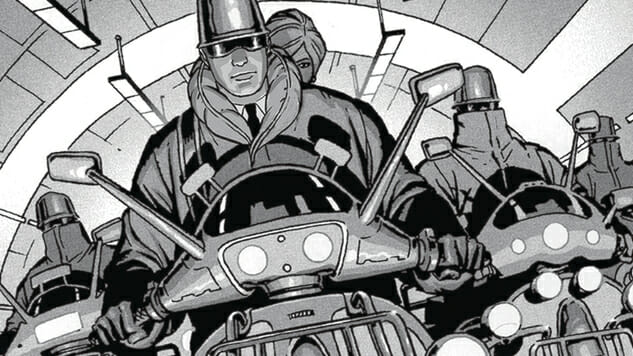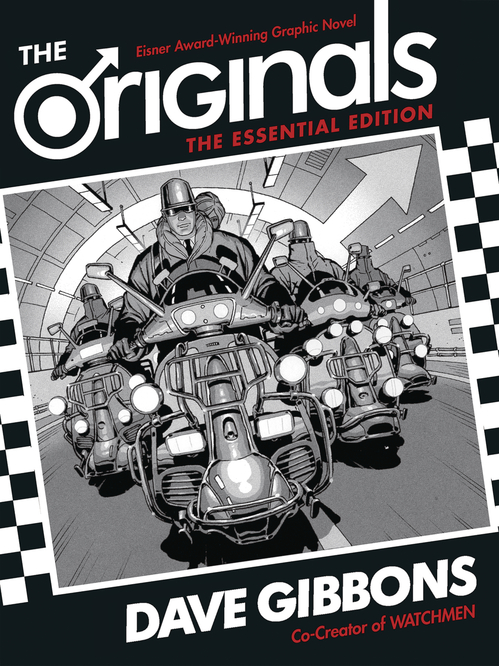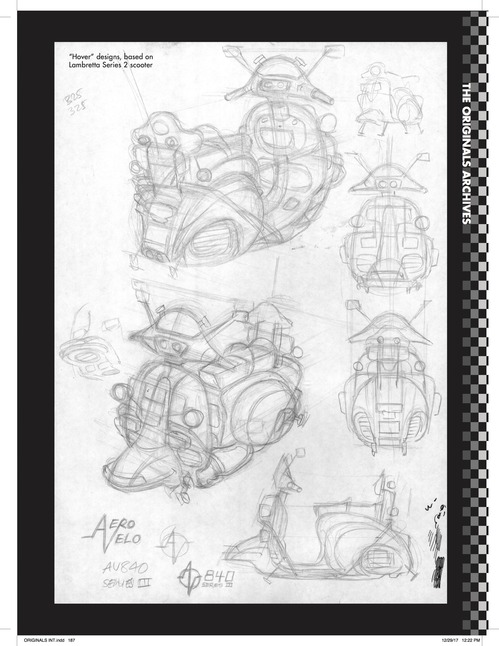Legendary Creator Dave Gibbons Looks Back on The Originals
The Watchmen Artist Reflects on His Eisner-Award-Winning Graphic Novel, Out This Week in an Essential Edition From Berger Books
Art by Dave Gibbons Comics Features Dave Gibbons
Dave Gibbons truly is an original, establishing himself in his native British comic scene before partnering with writers like Alan Moore and Frank Miller to create some of the medium’s most enduring works. While Watchmen looms large in his bibliography, Gibbons has also written for other artists, and struck out on his own for one long-form work: The Originals, first released by DC Comics’ Vertigo imprint in 2004, and out this week in a newly expanded edition from Dark Horse’s Berger Books imprint. Karen Berger first pushed Gibbons to conceive, write, illustrate and design the tale of warring youth gangs and the allure of cool, so it’s only fitting that her eponymous imprint should help bring the Eisner Award-winning graphic novel back into print for a new audience, complete with a host of process sketches, layouts and test pages. In advance of The Originals: The Essential Edition hitting shelves this Wednesday, Paste chatted with Gibbons about his work process, the art of collaboration and the growth of the comics medium throughout his decades in the industry.
![]()

The Originals: The Essential Edition Cover Art by Dave Gibbons
Paste Magazine: The Originals first came out 14 years ago, and I imagine you’re asked quite frequently about a certain book that debuted over 30 years ago. What’s it like for you, as an artist and storyteller, to look back on your past work so frequently? Is it easy to return to the headspace you were in when you first created the books, or does that feel like a different Dave altogether now?
Dave Gibbons: I don’t mind being asked about past projects! I think it’s amazing that there’s still an interest in my previous work. It’s just incredible to me that over 30 years later people are still finding new stuff and still want to ask new questions about Watchmen. The same goes for other projects I’ve done like Martha Washington and The Originals (currently). I’m just thrilled that these things have lasted for so long, and certainly for much longer than I thought they ever would!
No, I don’t think you can return to the headspace you were in when you created the books. And in some ways, that’s a good thing because most artists will tell you that they actually can’t stand their printed work, particularly when they first see it. They’ll see the mistakes or the things they could’ve done better. There’s something about a lot of time going by, like decades going by, that means you can look at it in a much more detached view. When you create a piece of art, you have the unique disadvantage that you alone out of anybody in the world can see in your mind’s eye what the creation could have been. Therefore, what the work actually is, results in an element of disappointment. On the other hand, everybody else in the world sees what the story is and not what it could’ve been. After a few years have gone by, you find yourself in the happier position of just being able to see what it is and think the work is okay.
Paste Magazine: You mentioned in your introduction that Karen Berger encouraged you to write and draw your own long-form comic for years before The Originals came about. I’ve seen you say elsewhere that you ultimately prefer collaboration. Do you see yourself returning to solo work in the near future, especially with Karen curating a new imprint? Or is it more fulfilling for you to work in a team of creators?
Gibbons: I’m kind of torn on that. I sort of have this idea that the “real” comics artist is someone that does the whole thing (writes the story, draws, colors and letters it, too). But on the other hand, that’s quite a lonely furrow. By the time you’ve written the story, you’re familiar with it and have read through it multiple times. By the time you’ve drawn it, you’re familiar with it and read it all once again. By the time you’ve colored and lettered it, you’re incredibly familiar with the story and have now read it many times. It becomes a bit like that joke that you feel you told once too often.
I’m really happy that I did The Originals by myself because out of all the projects I’ve done, it’s the most personal. It’s the most autobiographical, and I don’t think I’d really have liked to share it with anybody else or liked to see anyone else’s vision of it.
Generally, I do prefer for collaboration because you do bounce ideas back and forth. It’s nice to know that there’s at least one other person in the world who actually gives a rat’s ass about your story! Some of my happiest and most creative times have been spent in collaboration; whether I’m drawing somebody else’s script or I’m writing a script for someone else.
The Originals stands alone, but I do have a little niggling germ of an idea, which would be kind of a sequel. The story is so personal that it would be something that I’d do entirely by myself. I’m not really in the mood for doing it or in the place that I could do it right now, but who knows, at some point, I may very well do it. If I do go forward with creating a sequel, Berger Books would most definitely be my preferred home for it!

The Originals: The Essential Edition Interior Art by Dave Gibbons
Paste Magazine: The Originals draws heavily from the Mods but sci-fi touches like hover-scooters allow it to speak more broadly about youth movements and the teenage drive to belong and to prove yourself. Do you feel like anything on par with the Mods or the Grease could exist today, or is culture too fragmented and fast-moving for movements and trends like that?
Gibbons: The reason it’s called The Originals is because, not to be funny, but my generation was probably the first generation to set its own agenda. We all had jobs and enough money to indulge our taste in clothes, going out, music and scooters. We really were “the originals,” and there was nobody else like that really. People used to dress and behave like mini-versions of their parents, and then all of a sudden as Mods we were doing something that was quite similar to that but was actually fundamentally different. The Grease were kind of rebels as well, but they were too obvious. It was sort of a ham-fisted attempt at rebellion. I like the more secretive and disguised mode that Mods operated in. Your parents knew you looked smart, but they didn’t realize that you looked a particular way and it was like you were dressed in a camouflage. I don’t think there could be anything that was so polarizing as Mods and Grease.
I didn’t add the science fiction details to give The Originals a universal appeal. The first time I saw Mods and Mods scooters was almost like seeing people from another planet because they were so outside of my everyday experience. John Higgins, a colorist/collaborator on Watchmen, also pointed out to me that a big guy on a scooter looks kind of silly, and I thought that I’d need to add something to the story to make it look more impressive. I wanted the reader to be as impressed with the Mods scooters as I was when I first saw a Mod. I liked the idea of having some unexplained technology, which meant that the Mods scooters and Grease bikes float above the ground. Both groups having the technology implies that it’s relatively cheap and ubiquitous. I deliberately didn’t explain it, and I think for a long while in the book you don’t really notice it. Again, The Originals is based somewhere like post-war Britain, but it isn’t actually post-war Britain. It’s an alternate universe in the same way that the Watchmen universe is.

The Originals: The Essential Edition Interior Art by Dave Gibbons
Paste Magazine: There’s such a wealth of backmatter in this new edition. Do you keep extensive process files on all of your work? Did you feel any trepidation in sharing early versions of the book’s designs with the world?
Gibbons: It’s strange, but my inclination is nearly always to sell my original artwork once it’s seen print because I feel it’s kind of served its purpose. I do tend to hold onto scripts, sketches, layouts and thumbnails. I wrote a book called Watching the Watchmen, and that is composed more or less entirely of stuff that I saved from the days when I was doing the original art for the series. The Martha Washington book also has a huge sketchbook section as does The Originals.
I don’t actually mind showing people my early sketches because as a reader of comic books, I love to see the behind-the-scenes stuff. When you look at roughs, you can see what the creator went through and thought to arrive at the finished version. I find that really fascinating, and generally speaking, I try to write and draw the sort of things that I’m interested in reading. I enjoy a good, complete edition of a series with all the notes, the afterword and all the other extras.
Paste Magazine: You’re so closely associated with the nine-panel grid because of your work on Watchmen, but The Originals played with form much more—wide-panel shots of the hover-scooters pulling up, pages of posters and advertisements, swaths of black with narration. Was that an intentional push away from what you had done in the past? Were you drawing from any specific inspirations in laying out the book like that?
Gibbons: I knew that a book about Mods, style and being cool had to look very stylish and cool. With everything I do, I plan out the look of the books before I put pen to paper. I do experimental pages to see what it’s going to look like before I complete the artwork.
Yes, Watchmen was done in three-by-three grids. In fact, I think you’ll find that The Originals is also done on a grid, but it’s probably an eight-by-four grid. This means you can have all sorts of subdivisions of these pictures, but they always adhere to that basic grid. This design gives me the chance to have small and large pictures. Again, I wanted to put all the commentary outside the pictures, which is why that all appears in the black areas reversed out in white. The style and the overall look are very closely designed. I did The Originals in black and white because I felt that it suited the subject matter and gave it a slightly retro feel to make the book look a little more like a documentary.

The Originals: The Essential Edition Process Art by Dave Gibbons
Paste Magazine: A few years ago, you were appointed the United Kingdom’s first Comics Laureate to act as an ambassador for the medium and its ability to improve literacy. How did that experience shape your view of comics in the modern day? Is the industry keeping up with its audience and their needs?
Gibbons: It was a really interesting experience! Actually, it was almost like pushing on a door that wasn’t even locked. I found that unlike when I was growing up when teachers, librarians and parents generally disapproved of comics, nowadays, teachers and librarians actually love comics and are well-aware of how enticing they are for children to read. I didn’t experience a basic opposition to the very idea of comics. The main thing that participants wanted to know was what kind of comics they should buy and how they could be sure they had the appropriate comics for certain age groups. I was able to, with the help of the Comics Literacy Awareness, put together some reading lists and recommend certain books.
I also was able to work with Oxford University Press, a famous publisher of educational books, and we actually put a series of books of graphic texts (what they call comics). Some of these graphic texts are adapted from classic works of fiction and others are about the lives of scientists and explorers. Interestingly, we also adapted poetry, which I didn’t think would work but it worked surprisingly well. We received positive feedback from teachers because the adapted poetry provided wonderful talking points for students to discuss how they visualize the poem, what the artist was trying to do, and how they might have done it differently.
I think the industry is keeping up with the audience and their needs. We still have a lot of superhero books, but there are some really interesting independent comic books out there. There are books that exclusively aimed at grownups and other stories that are aimed at a younger audience; things like Adventure Time are incredibly popular amongst younger readers. It’s all about fostering the pleasure of reading. I’ve also been associated with a company called Madefire. Madefire produces digital comics, and yet, we have some bells and whistles like limited animation and sound to enhance the experience, but still the emphasis is on actually reading and moving on through the story at your own pace. I think that in one way or another, the industry keeps up with its audience.
Paste Magazine: We haven’t seen much comics work from you in the last five or six years. What’s kept you busy outside of the industry? And when might we expect to see you return?
Gibbons: It’s funny. I’ve done comics for a long time, more than 40 years now, and I’ve done so much writing and drawing of comics that allowed me to, in some ways, realize my ambitions. Nowadays, I’m much more interested in storytelling technology. I mentioned Madefire earlier on, which has been an interesting experience for me. I’m working with some wonderfully innovative and enthusiastic people. I’m also involved in a company called Magic Leap. This company has some absolutely breakthrough revolutionary technology, which will impact storytelling and other aspects of life. I think people will start to see this technology later this year and it’s been a great honor to be involved in something as revolutionary and magical as what they’re doing. I’m also working in collaboration with a well-known musician for an experience, which we’re going to deliver using Madefire and Magic Leap technologies. I best not say any more on that!
I also wrote a book on comics, How Comics Work, in collaboration with Tim Pilcher. It came out last year and was very well received. Again, this is exactly the kind of book that I like to read, and we’ve actually been nominated for an Eisner Award for Best Comics-Related Publications, which is a huge thrill! I should also say that I personally have been nominated in the Eisner Hall of Fame, which has got some incredible artists and writers in it. It’s truly a great thrill just to be nominated. The competition, as always, is pretty stiff, but I’m thrilled about that.
The University of Dundee awarded me an honorary doctorate, and they have the first masters-level course of comic art in the U.K. I have a personal connection with Dundee as well. My father used to live there when he was a child, and I go way, way back with DC Thomson.
I’ve also been working on my autobiography, which is pretty much written. Once again, I’m going through my extensive archives pulling out things I illustrated. Hopefully, the autobiography will be out later this year sometime or early next year.

The Originals: The Essential Edition Process Art by Dave Gibbons